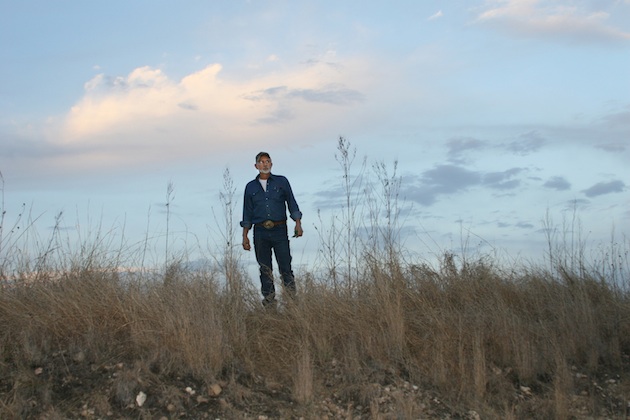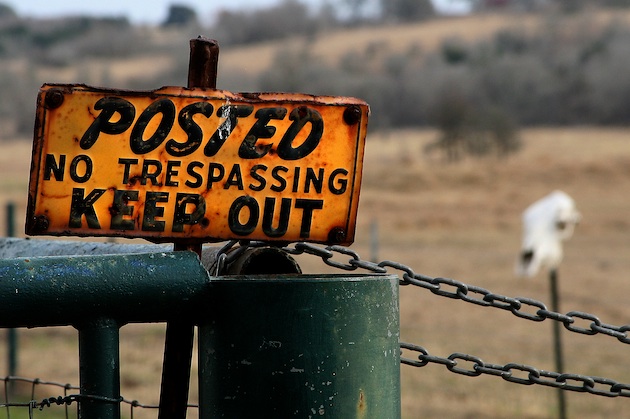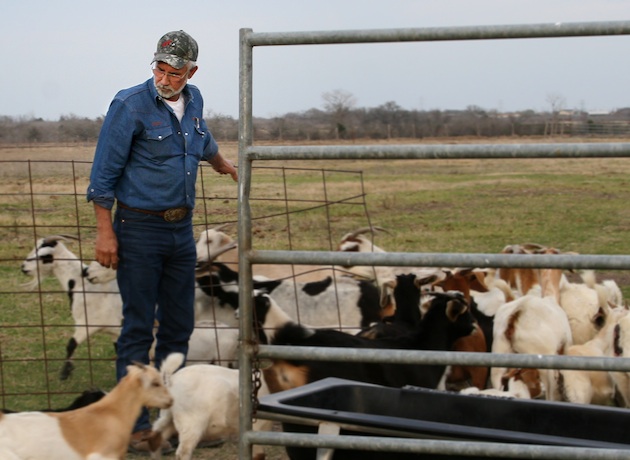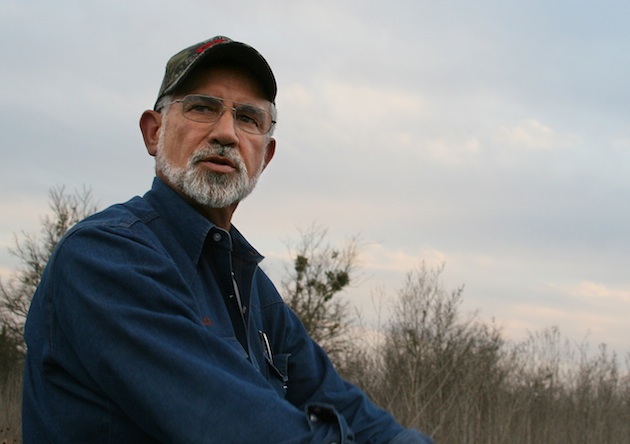A confrontation between neighbors. Criminal charges and disappearing evidence. A road project in Uhland is the latest fuel for this small-town feud.

Gordon Sassman’s heart was racing. His hands were shaking. He was so wound up, he hadn’t gotten an ounce of sleep in nearly a week.
This was a bad sign. Only a month before, Sassman had nearly died. The heart attack had hit him like a backhoe pressing down on his chest. He’d spent 10 days in the hospital.
Now Sassman, 61, was back home in Uhland, where he’s an alderman on the city council. He was supposed to be recuperating, but his many responsibilities kept interfering with the recovery.
“My heart is so stressed out,” he said. “I don’t need all this extra stress, but I’ve been kind of a main person here in town, overseeing all these different things.”
His latest source of stress? The controversy keeping him awake at night?
Seeliger Drive. A gravel road.
It had been a good road, he said, before the city hired a street crew to dig it all up. Cost the taxpayers of Uhland nearly $2,000.
Sassman, a month removed from his heart attack, could feel the blood boiling in his veins.
A PETTY CONFLICT?
Uhland’s city council met on March 2. The next day, when reached on his cell phone, Sassman said he was more stressed than ever. His heart was still pounding. His hands were still shaking. Two Uhland residents had spoken against him during the public comment session of the meeting.
“They stood up there in that public comment and told nothing but lies on me,” Sassman said. “You’d of thought I was a monster. Just lies, lies, lies, lies, lies.”
One of the speakers had even threatened Sassman with violence, Sassman said. The man stood before everybody — all the aldermen, members of a regional water-planning group, the president of the local economic development council, everybody — and said that Sassman’s days were numbered.
The man said he was prepared to die in his fight against the alderman.
“He made some serious threats on me,” Sassman said. “I gotta do something for protection right now.”
And to think it all traces back to one gravel road in a little town full of them.
Settled in the 1800s, Uhland nestles into a fertile valley where the old Camino Real crosses Plum Creek. The town’s modest farm houses are scattered among plowed fields of rich, black soil, and the creek wends past a few storefronts, mostly vacant, that stand in for downtown. Fading into the distance are gentle, green hills given over to mesquite.
The sleepy setting belies some major changes under way. Uhland, which straddles the Hays-Caldwell county line about 30 miles southeast of Austin, is one of many rural communities that are being swallowed by Austin’s suburban push outward.
After a decade of growth, new residents in Uhland outnumber the old-timers by a margin of nearly three to one. The total population is up to 1,014, and neighborhoods of low-slung doublewides are beginning to crowd out some of the farm land. Another big residential development is in the works, and there’s even talk of getting a gas station or two.
In October, disaster struck. Uhland’s legendary dancehall — the 117-year-old Club 21 — burned to the ground, severing one of the town’s most enduring ties to its past.
When asked about Sassman and his gravel road, Mayor Daniel Heideman didn’t sound overly concerned.
“I don’t know what the problem really is,” Heideman said.
A year or so earlier, he explained, a road crew had laid a new gravel base on Seeliger Drive, an unpaved street around the block from city hall. Seeliger Drive is about 200 yards long. The new base raised the road by about a foot and a half.
Then the rainy season came, and town officials realized they’d made a mistake. Rainwater that had always flowed downhill, draining into Plum Creek, was now being trapped by the freshly elevated roadway. The water was puddling and flooding in people’s front yards.
Residents said the puddles smelled like sewage. They blamed the effluent on leaky septic tanks from the big new neighborhoods farther uphill.
To fix the drainage problem, Heideman said, the town’s engineers suggested a small section of the road be lowered, returning it to its original level. That way, water could flow over the road and into the creek.
On Feb. 22, road crews removed the new gravel base from the last little bit of Seeliger Drive. In all, a length of less than 40 yards was affected.
“I don’t know what else to tell you,” Heideman said.
Surely there was more to the story.

FIGHTING A BULLY
Since Club 21 burned to the ground, the most notable building in town is the old schoolhouse. The school was converted into a community center after the local children began attending class in Kyle, about eight miles to the west.
City hall occupies the north end of the community building. On Friday morning, the town’s only paid employee, city secretary Karen Gallaher, was answering phones at her desk in a corner of the room. Faded portraits of George Washington and Abraham Lincoln hung on the wall.
Gallaher said she lives in the last house on Seeliger Drive, the gravel road at the center of the controversy. Gallaher’s husband, Chuck Schilhab, had intended to speak against Sassman at the city council meeting, but his son had soccer practice that day. So instead, he wrote a one-page letter. Another Uhland resident then read the letter to the aldermen.
In the letter, Schilhab claimed that different people on Seeliger Drive have been confronted by Sassman over the past couple of years. One of the confrontations led to a fistfight. Schilhab had experienced his own run-in with Sassman just that week.
“I saw first hand that the reports of him being a bully and harassing people were true just by the way he tried to handle his situation with me,” Schilhab wrote in his letter. “He is an aggressive, combative person and does not represent Uhland well at all.”
The other person who spoke against Sassman was a Uhland resident named David Ayala. Ayala also lives on Seeliger Drive, in the house next door to Gallaher, Schilhab and their children.
The aldermen record all of their meetings. The audio recording of Ayala’s speech wasn’t available at the moment, the city secretary said, but it would be made available a few days later, on Monday.
Over at Seeliger Drive on Friday afternoon, Ayala was walking across the gravel street with the help of a metal cane. He declined to comment, saying only that “around here, Gordon is the law.”
Toward the end of the road, the gravel slopes downward about 18 inches before leveling off again on its way to the cattle guard at Sassman’s place. The decline is noticeable, but even so, it’s less mountain than molehill. Across the street from the house owned by the city secretary and her husband, a few cows were chewing on a couple of hay bales. A faint scent of hay, mingled with urine and dung, wafted over to the lawn where Schilhab was standing.
“After the road gets lowered, he drops off this hay in front of my house,” Schilhab said. “He had never fed the cows there till now.”
That wasn’t the only retribution, according to Schilhab. Gray water from Schilhab and Gallaher’s house had always been released through the fence onto Sassman’s pasture, but after the road was lowered, Sassman told them to get their sewer water off his land. One day Schilhab noticed Sassman taking photos of the gray water being discharged there.
“Gordon, what are you doing?” Schilhab asked him.
“He sees me and takes off running for his tractor. Because he’s embarrassed,” Schilhab recalled. “Then he gets back into his fighting stance.”
“What are you gonna do about it?” Sassman asked, according to Schilhab.
“He was stepping toward me, trying to egg me on to have a fistfight,” Schilhab continued. “He’s a big dude. He’s got hands like mallets. He might be 60-something, but he can still put on ass-whooping on you.”
Two years ago, Sassman allegedly gave a whooping to Ayala, the disabled man who lives up the street. After the fight, Ayala was hauled off in an ambulance. Sassman was charged with assault, a misdemeanor, but the case was dismissed a few months later for lack of evidence. (The Hays Free Press has requested a copy of the sheriff’s investigation report).
“He’s been bullying people on this street for years now,” Schilhab said. “People are afraid of him.”
If Sassman lived there, he wouldn’t want his lawn to be flooded every time it rains. “My kids play here,” Schilhab said. “You wouldn’t want your kids playing in other people’s water. Why do we gotta live in pee and poop?”
“I’m a peaceful man,” he said, “and I can’t understand why he’s acting this way.”
It was time to go ask Sassman that.

SASSMAN SPEAKS
He was sitting at a cluttered desk in the office of the shop where he sells and repairs air compressors and hydraulic equipment, a few buildings down from city hall. He wore a silver beard and bifocals. Embroidered above the pockets of his blue denim shirt were his first name, Gordon, and the name of his business, Gordon’s Equipment.
“Look at this,” he said, lifting a stack of work orders. “I’m a busy person. I go seven days a week.”
In addition to his 22 years as an alderman, Sassman was a volunteer firefighter for 25. He mows the grass around the community center and in the past has organized roadside cleanup events. There’s no police officer on the payroll, so Sassman keeps watch for wrongdoing as well.
“I’m constantly observing everybody and looking for problems,” he said.
In the spring of 2009, Sassman noticed a problem that he found particularly galling. He’d be cruising along Seeliger Drive — the gravel road in question — and he’d notice a federal vehicle parked in front of David Ayala’s house. Ayala had been driving a work-issued vehicle home during lunch breaks. He worked for the Gary Job Corps, a federal job-training facility in San Marcos, nine miles down the road.
“I’m a taxpayer. You’re a taxpayer,” Sassman said. “Do you think that’s right? You and I are paying taxes on that.”
Sassman waited until Ayala was nowhere in sight. Then he started snapping pictures of the car and its federal license plate. Ayala was evidently peeping around the corner. He got right up in Sassman’s face — here, to demonstrate, Sassman glowered and pressed his nose into the face of this reporter — and then, according to Sassman, Ayala shoved him.
“Defending myself, I pinned him to the ground and gave him every opportunity to stop fighting,” Sassman said. “I was restraining him to keep him from hitting me, and his (adult) daughter ran up and plowed into me from behind.”
When the scuffle was over, Sassman and Ayala shook hands, and Sassman thought the matter had been resolved. Instead, Ayala called the sheriff’s department.
“They believed him because he can lie really good,” Sassman said. “So I was arrested.”
As noted earlier, the charges against Sassman were eventually dropped. Ayala lost his job. According to Sassman, Ayala now flips him the bird every time Sassman drives down the street. And whenever Ayala flips him off, Sassman makes note of it and reports the incident to the Caldwell County Sheriff’s Office.
“Just last week I called two times,” Sassman said. “He does this all the time.”
Now, in response to Ayala’s threats during the public comment period, Sassman was taking legal precautions against the “madman,” as Sassman called him. He had to protect himself and his fellow residents. Sassman also wanted to get a copy of the audio recording from Wednesday’s council meeting, before anything happened to it. He said he wouldn’t be surprised if the recording was somehow lost or destroyed over the weekend.
The audio was at the city hall, with the city secretary. And according to Sassman, the city secretary and her husband were aligned with Ayala — against Sassman.
All of this could have been avoided, he said, if the city had just listened to him in the first place.
Rather than tearing up Seeliger Drive, Sassman had suggested the city dig a ditch along the uphill side of the road. That way, the runoff water would have flowed through a culvert at the beginning of the street and into Plum Creek.
Now, more water than ever has been flowing onto Sassman’s property. Meanwhile, all that running water has been weakening the road’s foundation.
“What really upsets me,” he said, “is that taxpayers paid for that base. It doesn’t benefit anyone on the street but (the city secretary). A lot of people have got drainage issues, but this is the only one where anything is done about it.”
Since the older part of Uhland is situated in the creek’s floodplain, where all the runoff water flows, drainage is becoming a more serious issue than ever. Uhland, though, has taken some measures to control the runoff. Huge drainage ditches around the city’s newer neighborhoods divert the effluent onto Sassman’s property.
“Can you blame me for not wanting a little bit more on me?” he said.
What’s more, the ditches are being eroded so quickly that Sassman calls them “Grand Canyon No. 2.” On Friday afternoon, he drove over to the neighborhood and stood at the bottom of one of the biggest ditches, waving his hat in the air to show how deep it was. If only the city had heeded Sassman’s advice, the erosion could have been controlled.
“You might think I’m an idiot,” Sassman said. “But if you do, then you’re an idiot. Because what I say is a fact. It’s a proven fact.”
The problem is, people just won’t listen. Sassman is trying to clean up Uhland and do something with the town, but it’s a tough battle when people won’t work with him. The unfolding drama on Seeliger Drive is a case in point. And to think, he added, “I pay more taxes than anyone else on the street.”
Everywhere he looks, Sassman sees trash. His neighbors’ yards are a filthy mess. People throw out their garbage, and it blows onto his property. Every mesquite bush on his ranch has a dang plastic bag in it. Nobody cares.
In his old age Sassman has developed into something of a “germ freak,” he said. He takes two showers a day and only drinks bottled water — nothing from the faucet. It’s a far cry from the stuff he used to drink when he was a boy. In those days he would draw the water from a well in a bucket, then pour it from one bucket into another, using cheesecloth to strain off the grasshoppers and other bugs.
“Dad died when I was 14 years old,” he said. “We lived in a shack with no running water.” He paused for a moment, reflecting. Then he said: “I came a long way. I came a long way on my own.”
Now he’s 61 years old, a successful businessman and community leader. But he can’t sleep. His hands are shaking. His heart is in no condition for all this strain.
“I want to quit,” he said, “I really do. But what’s gonna happen to the town when I quit? It’s just gonna get worse. At least I have a vote in it now.”

THE LAST STAND
On Monday morning, Sassman marched into city hall with a couple of gun-toting sheriff’s deputies. They had come to confiscate the audio recording of Ayala’s rant during the public comment session.
It was the same audio recording the Free Press was scheduled to hear later that morning.
But when the city secretary tried to locate the audio file, on the computer next to the aldermen’s dais, she couldn’t find it. Just as Sassman had predicted, the audio file had disappeared, and the deputies eventually left empty-handed. Sassman led the lawmen over to his pasture, and they walked around for a while in the dry grass, looking at the backs of his neighbors’ houses.
Sassman handed a letter to the deputies asking them to file charges against Ayala for making a terroristic threat against him during the council meeting. The letter also asked the sheriff’s office to issue a restraining order against the neighbor.
The deputies told him it would take about 10 days to process. Then they left.
“I have to get to work,” Sassman said, climbing into his pickup.
The Friday before, he had sat in the same pickup and talked about his heart condition and the arthritis clenching up his joints. He also talked of becoming a grandpa. The other day, Sassman was cradling his newborn grandson in his arms and trying to get the baby’s attention. He wanted to make eye contact with him, but the baby was too mesmerized by the wildlife mounted on the wall — a mule deer shot in Colorado and a good white-tail buck taken on the family land in Uhland.
“That’s all he would look at,” Sassman said.
Sassman wants to live long enough, and remain fit enough, to teach his grandson to ride a horse someday. With his heart the way it is, and all the stress he’s been under, that’s no sure bet. Sassman was fortunate to have survived the last heart attack.
“I coulda died in January,” he said, “but the good Lord looks after good people.”
And in Uhland, for better or worse, Gordon Sassman looks after everyone else.
First published March 9, 2011, in the Hays Free Press.
65 responses to “Sassman’s last stand”
I really believe that a foreclosed can have a important effect on the client’s life. Real estate foreclosures can have a 7 to a decade negative affect on a borrower’s credit report. A borrower who may have applied for a home loan or any loans for that matter, knows that the actual worse credit rating is definitely, the more hard it is to obtain a decent personal loan. In addition, it can affect any borrower’s chance to find a respectable place to let or hire, if that gets the alternative housing solution. Good blog post.
The Best Premium IPTV Service WorldWide!
I really appreciate this post. I have been looking all over for this! Thank goodness I found it on Bing. You have made my day! Thx again!
Good – I should definitely pronounce, impressed with your web site. I had no trouble navigating through all tabs as well as related info ended up being truly easy to do to access. I recently found what I hoped for before you know it in the least. Quite unusual. Is likely to appreciate it for those who add forums or anything, site theme . a tones way for your customer to communicate. Nice task.
Wow! This could be one particular of the most beneficial blogs We’ve ever arrive across on this subject. Basically Great. I am also a specialist in this topic so I can understand your hard work.
But wanna input on few general things, The website design and style is perfect, the written content is rattling wonderful. “Crime does not pay … as well as politics.” by Alfred E. Newman.
Merely a smiling visitor here to share the love (:, btw outstanding design. “Competition is a painful thing, but it produces great results.” by Jerry Flint.
610939 759571Deference to op , some superb entropy. 479776
595426 454337?Xanax (Alprazolam) is used to treat anxiety disorders and panic attacks. Alprazolam is in a class of ? 941837
611395 807612Really interesting subject , thanks for putting up. 975237
764939 923399Hey there! Great post! Please do tell us when we shall see a follow up! 373673
752907 139286Aw, this was a actually good post. In concept I wish to put in writing like this moreover ?taking time and actual effort to make an outstanding article?however what can I say?I procrastinate alot and by no indicates seem to get something done. 809152
439778 915854Some genuinely good info , Gladiola I observed this. 380034
107525 991655Terrific paintings! That may be the type of data that are meant to be shared about the net. Shame on the seek for no longer positioning this publish higher! Come on over and consult with my web site . Thank you =) 625483
402582 10460Good weblog! Only issue is i?m running Firefox on Debian, and the site is seeking just a little.. weird! Perhaps you could want to test it to see for yourself. 678304